Racecars roar in NASCAR’s return to Lime Rock Park
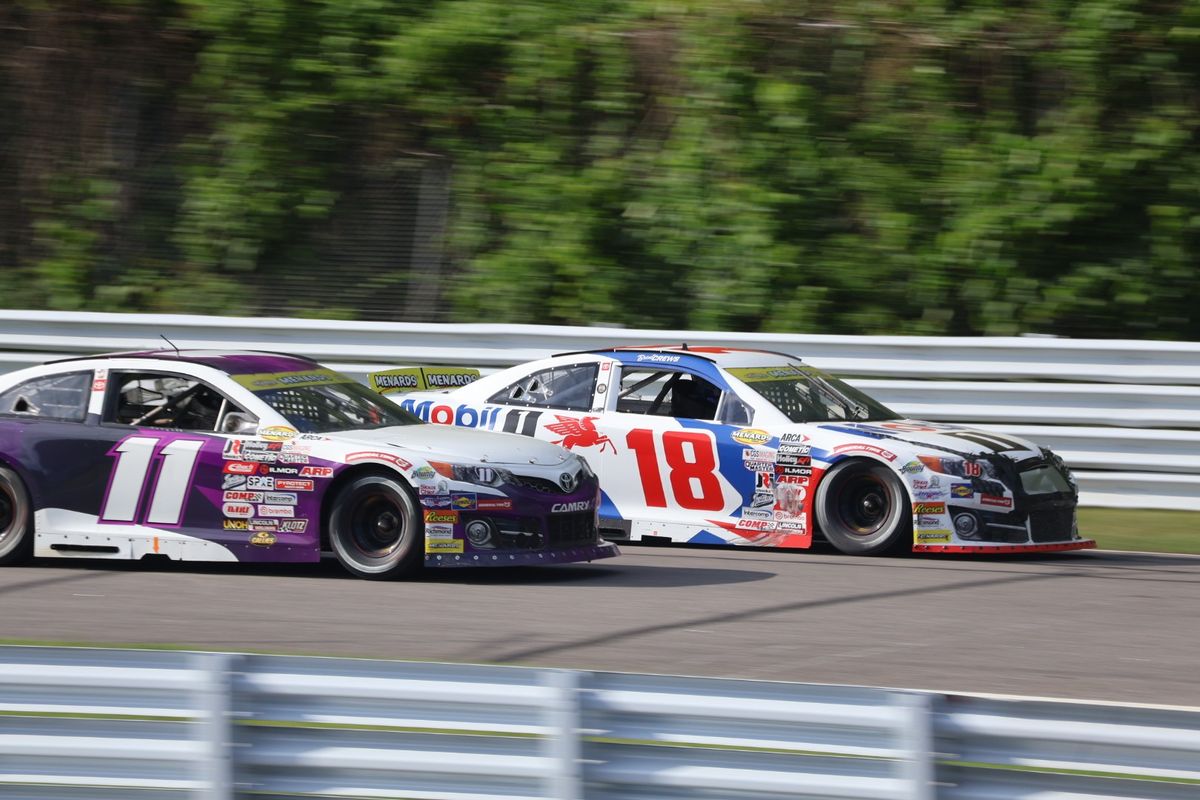
High-speed action made for a weekend of excitement at Lime Rock Park Friday and Saturday, June 27-28.
Photo by Simon Markow

High-speed action made for a weekend of excitement at Lime Rock Park Friday and Saturday, June 27-28.
LAKEVILLE — For the first time since 2011, Lime Rock Park hosted National Association for Stock Car Auto Racing events June 27 and 28.
It was billed as the largest event in modern track history with an estimated 20,000 fans attending.
The action kicked off Thursday, June 26, when a massive hauler parade rolled into town. A “Pit Stop Party” was held at the White Hart Inn in Salisbury where drivers signed autographs and met with fans.
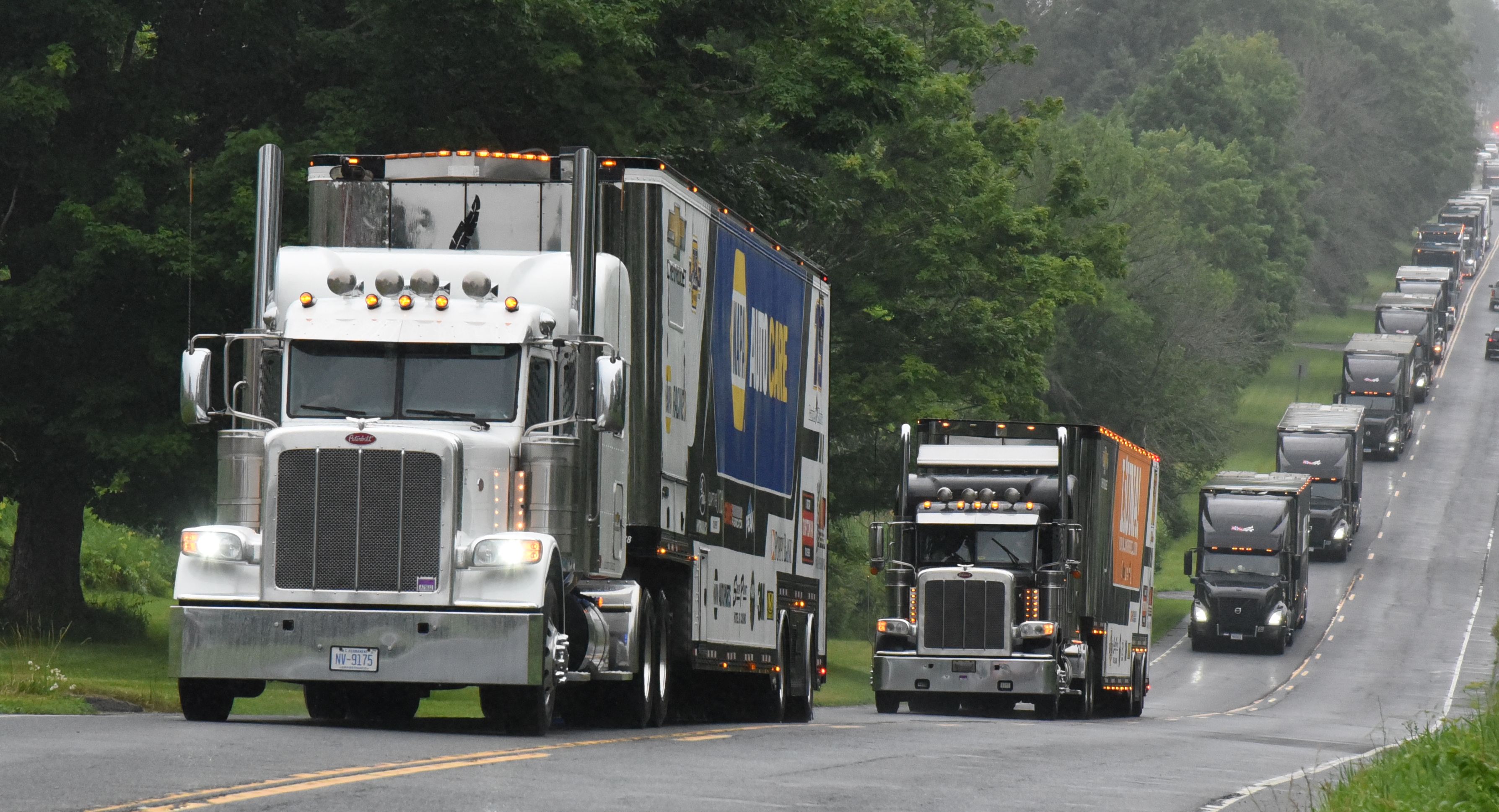
Dan Winkley, hotel manager at the White Hart, said, “We’re super excited to have NASCAR in our town. We have elevated our staffing levels. We’ve got all hands on deck ready to go to welcome in the big crowds.”
One of the drivers at the White Hart was Ben Maier, a 16-year-old making his NASCAR truck series debut. “I’m pretty excited to just figure out the car and figure out what I’m getting into,” he said.
Toni Breidinger, the lone female truck racer of the weekend, said, “I’m most excited to be at a new track. I’ve never been here before, so I think that’s really fun.”
Maier and Breidinger both competed in the NASCAR Craftsman Truck Series, a national circuit known for launching the careers of stars like Kyle Busch, Kevin Harvick and Chase Elliott.
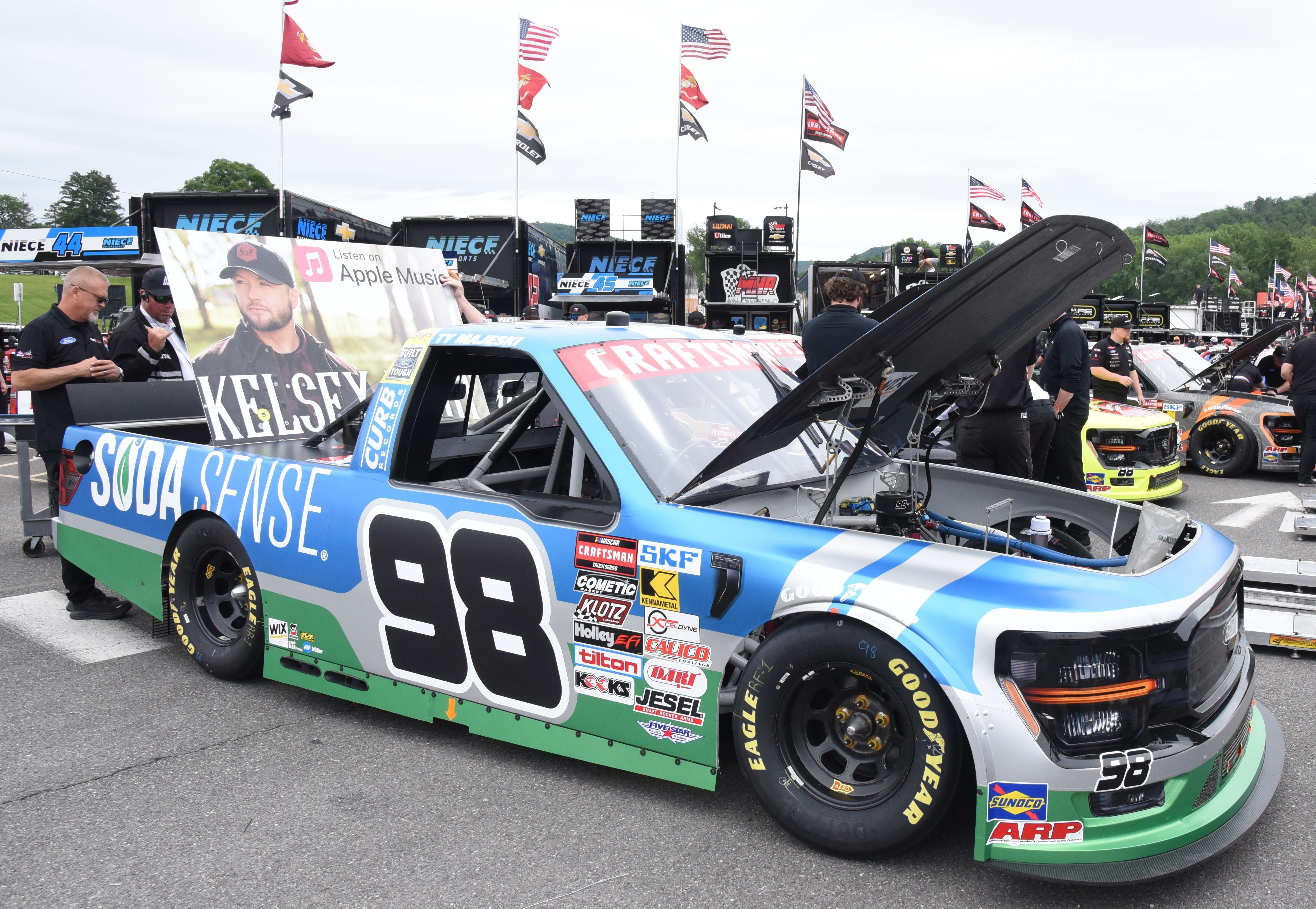
On Friday, June 27, at about 11 a.m., the members of the parking team at Trinity Episcopal Church across the street from Lime Rock Park were ready for action. Visitors could park their cars in the field and take a short and leisurely stroll over to the track.
Meanwhile, crews were hard at work in the paddocks. Drivers prepared for racing, emergency personnel were on duty and the LRP staff helped guests enjoy a day at the track.
Buz McCall, driving a 1998 Monte Carlo, was getting laps in ahead of the NASCAR Classic series race later that night. At 78 years old, McCall was the oldest driver of the weekend. His opponent, Ray Webb, had raced against McCall many times in the past and said he remains a tough competitor. “He’s still got it. Oh yeah.”
Kent firefighter P.J. Haviland was stationed near the pit lane in case of emergency. He said training for the event was extensive and covered most possible scenarios. “It was a simulator,” Haviland explained, which included extinguishing propane fires, cutting off power inside cars, removing steering wheels and similar rescue procedures. Of his trackside post, he said “It’s great.”
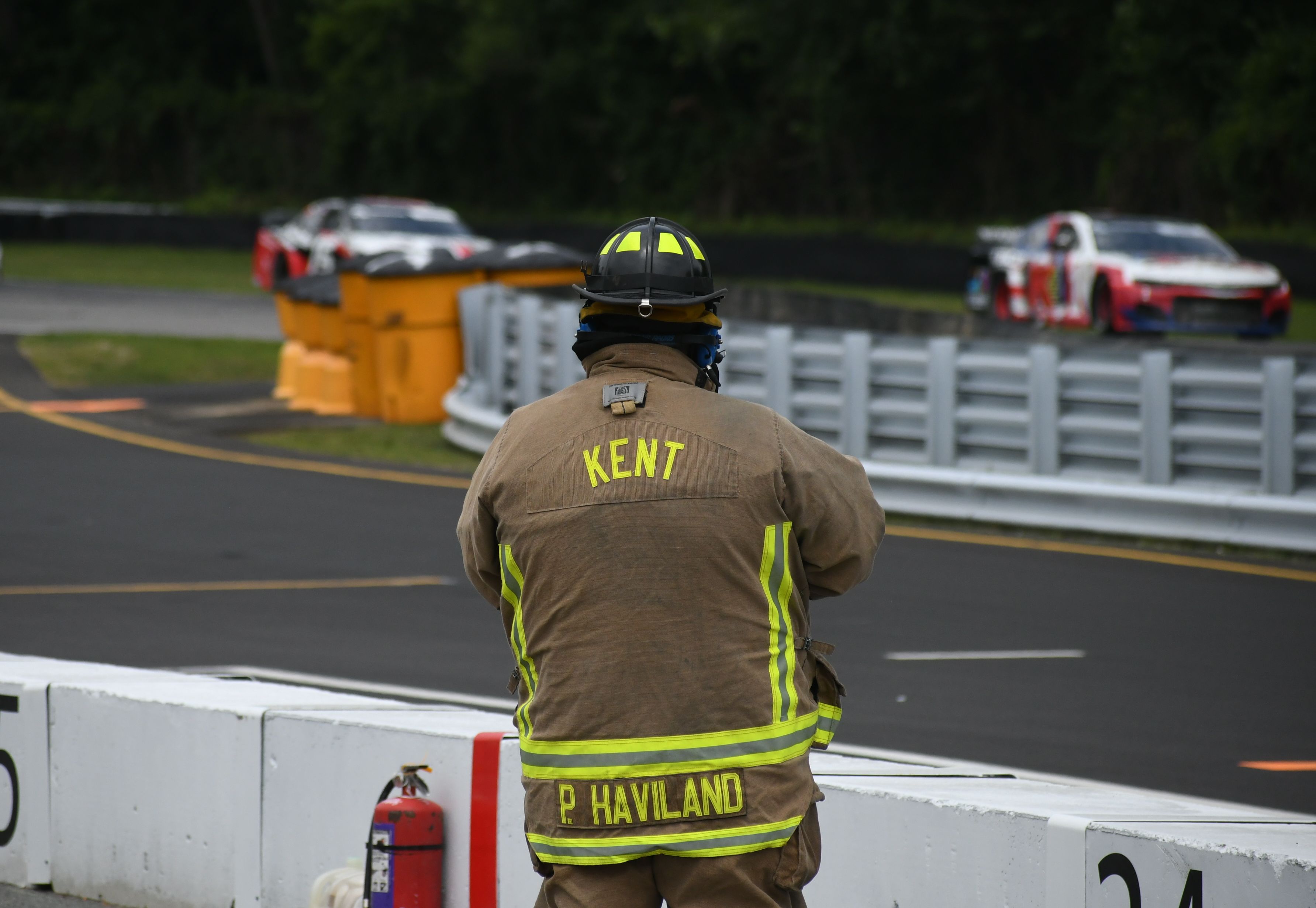
Some current Housatonic Valley Regional High School students were hard at work in the Paddock Concession Stand. During a lull in the line, Gustavo Portillo, Wyatt Merwin and Sam Berry spoke of the efforts that went into the weekend.
“It was a lot of prep. A lot of wrapping, burgers, patties and everything,” said Portillo. “It hasn’t been too busy,” Portillo said of the Friday crowd, but Berry noted, “The main races are tomorrow.”
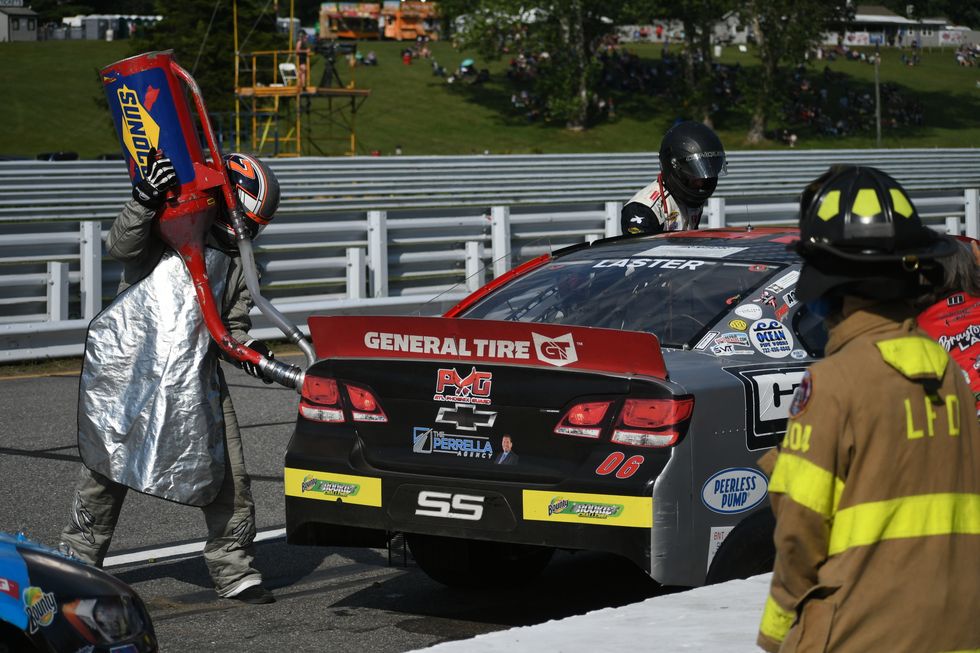
Saturday afternoon brought perfect summer weather for the NASCAR Craftsman Truck LIUNA 150 Race at 1 p.m.
Rev. Heidi Truax of Trinity Episcopal Church gave the pre-race invocation.
“Racing in beautiful Lime Rock reminds me of the psalm 'I lift up my eyes to the hills,' but our eyes are focused right now on the track, not so much the hills,” she said at the start of her prayer.
The park was packed for race day.
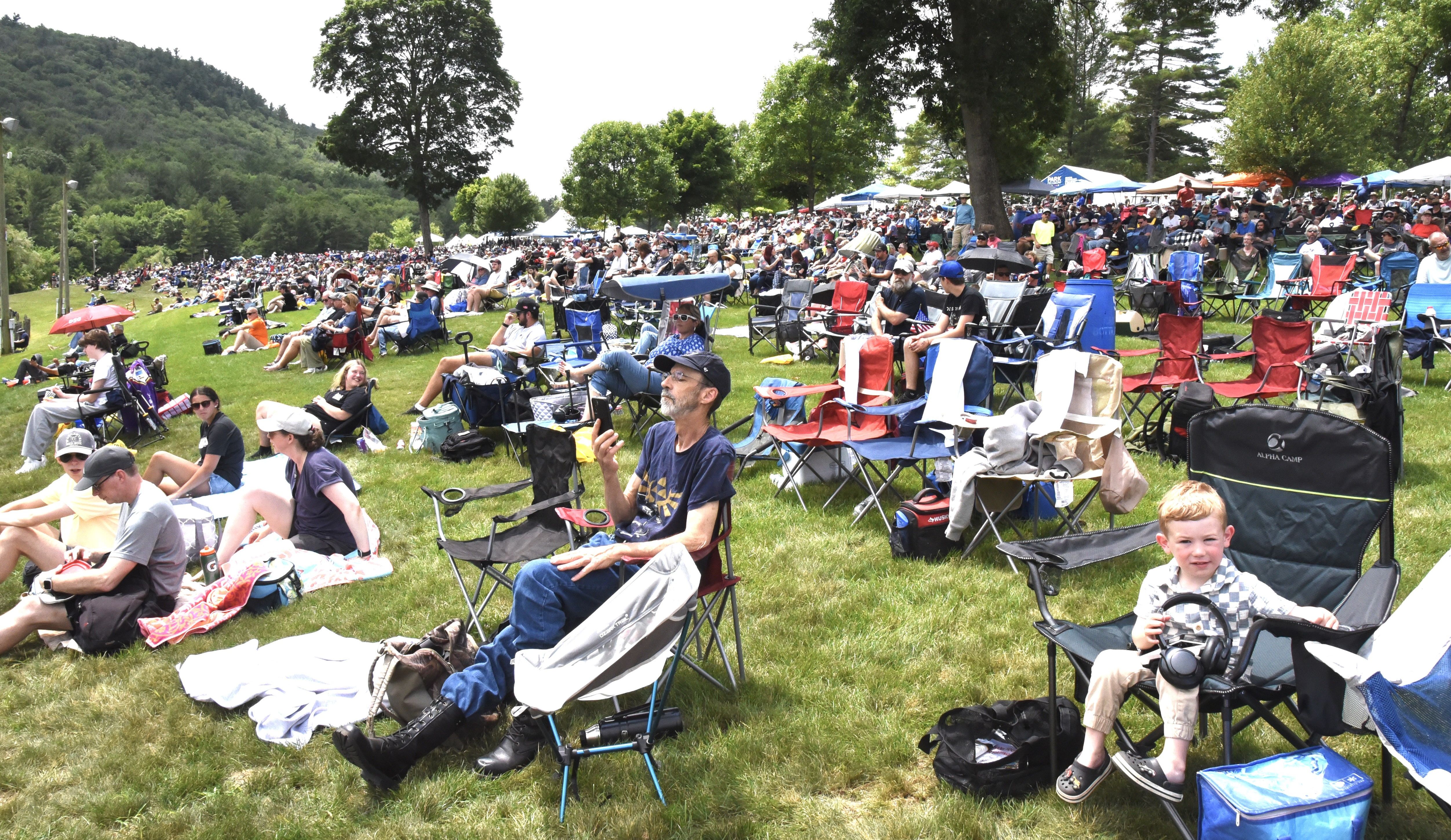
Finn Scribner, of Torrington, was attending his first NASCAR race. “It’s good. It’s loud,” said Scribner. “First time I’ve been here since I was 5 or 6. My grandparents got me tickets for my birthday.”
Frankie Muniz, former star of the TV show “Malcom in the Middle,” competed in the truck series race driving the No. 33 Ford F-150.
The LIUNA 150 was won by Corey Heim in dominant fashion, leading nearly every lap of the race. It was his fifth Craftsman Truck series win this season.
After his first-ever race in Lakeville, Heim said, “Seeing the atmosphere and the fans that came out was super cool. Everyone seemed so excited to have NASCAR at Lime Rock. Really hoping they continue this trend and we can come back in the future.”
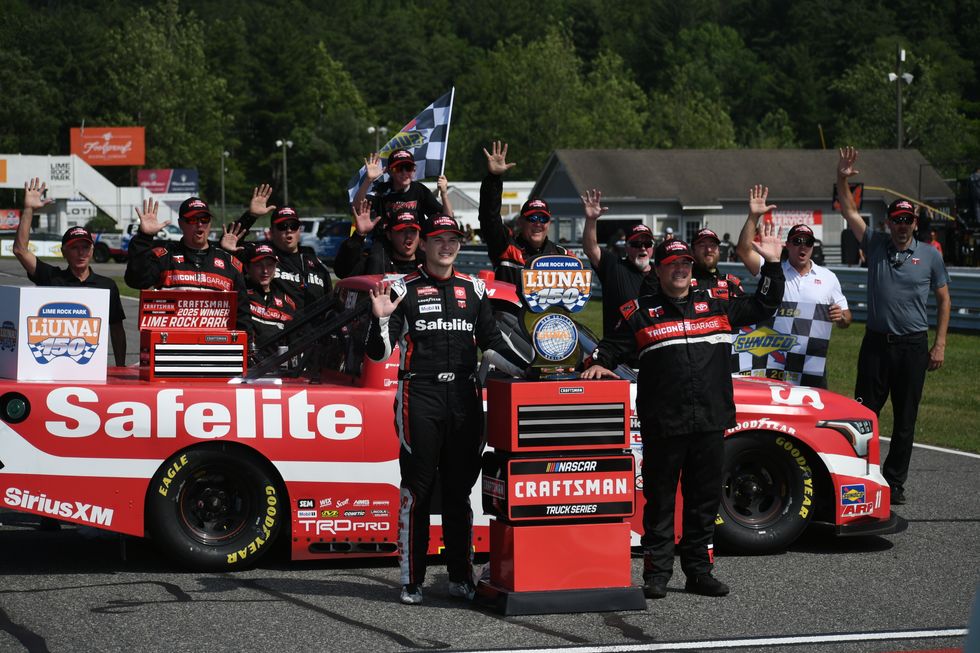
The ARCA Menards Lime Rock Park 100 was won by Thomas Annunziata, marking his first career ARCA victory. It was his second race at LRP this year after finishing 2nd in the Trans Am 2 Classic in May.
Lime Rock Park CEO Dicky Riegel commented on Annunziata, “He’s a son of Lime Rock Park. You know, that guy, all he does here is win and podium.”

At the end of the action-packed weekend, Riegel said, “It’s been amazing. After three years of putting this together, it’s just been fantastic.”
Concrete attendance numbers were not available, but Riegel said it was “absolutely a modern record for this place.”
This article was written by Riley Klein with reporting from Simon Markow.
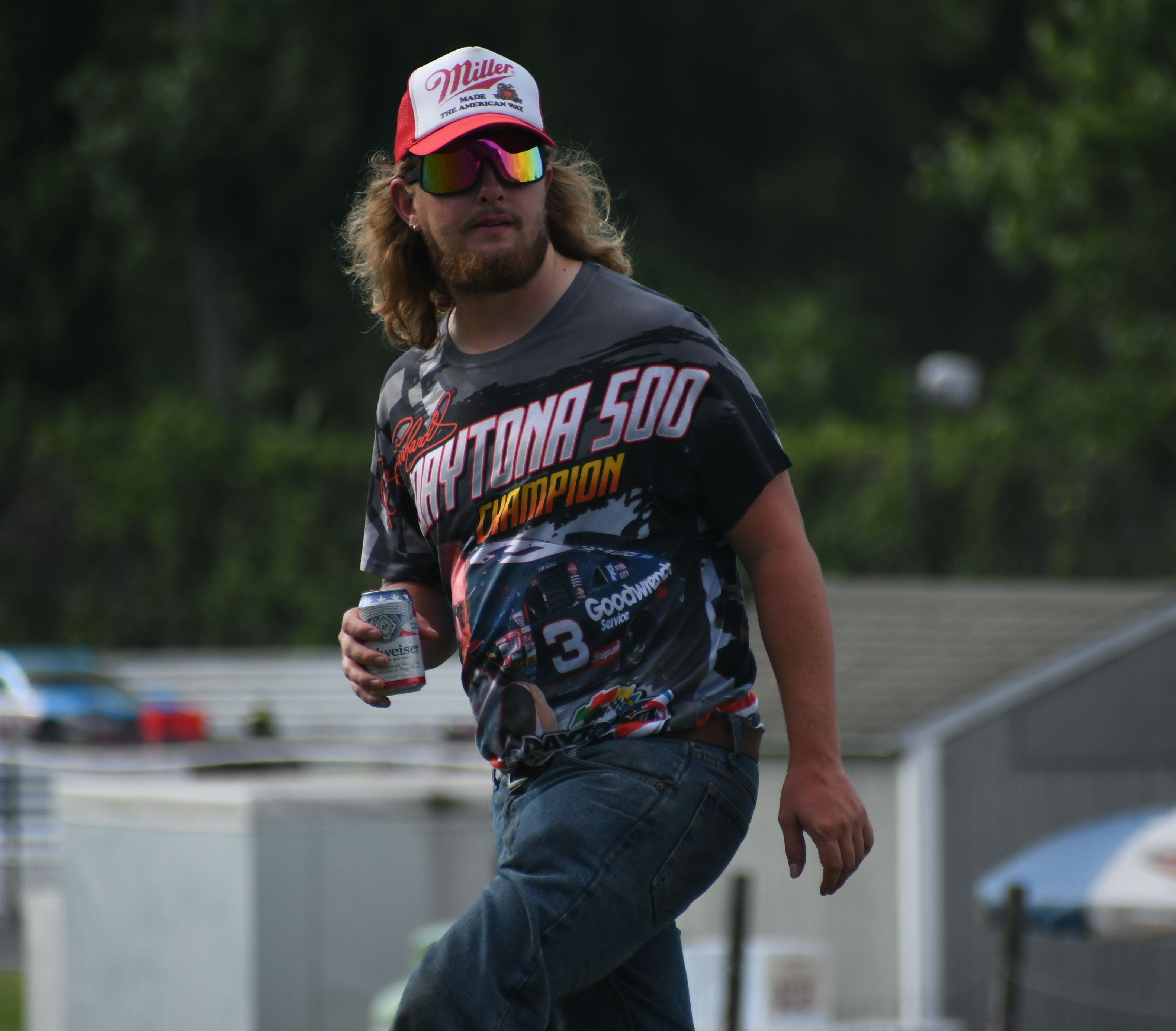
FALLS VILLAGE — The Board of Selectmen at its Dec. 17 meeting heard concerns about the condition of Sand Road.
First Selectman David Barger reported a resident came before the board to talk about the road that is often used as feeder between Salisbury and Canaan.
“The person said there is not proper maintenance of that road and it is often the scene of accidents,” Barger said in a phone interview. “There is a problem with the canopy of trees that hang over it, making it hard to keep clear, but there is also the problem of speeding, which is terrible.”
As a former state trooper, he said he is familiar with the problem of drivers going too fast on that road, describing one case in which he had to charge someone for traveling way above the speed limit.
Barger said the town cannot reconfigure the roadway at this time, but officials and road crew members will keep an extra eye on it as a short-term solution.
In other business, Barger said the selectmen plan to call a town meeting sometime next month. Residents will be asked to take the remaining funds, which total $48,200, from the non-recurring capital fund to allow for Allied Engineering to perform engineering studies on the proposed salt shed. Money for construction has already been secured through a STEAP grant, which the town received in the amount of $625,000.
“We’re looking at critical infrastructure projects and this is one component,” he said.
At that town meeting, there will also be a vote to take $2,000 from the town’s discretionary fund to pay Cardinal Engineering for work on repair of the Cobble Road bridge.
About 40 people gathered on the lawn of the White Hart Inn on Sunday, Dec. 14, to mark the anniversary of the Sandy Hook Elementary School shooting.
SALISBURY — Despite frigid temperatures, about 40 people gathered Dec. 14 on the snowy lawn outside the White Hart Inn for an evening vigil honoring the 20 children and six educators killed at Sandy Hook Elementary School, as well as victims of gun violence nationwide and around the world.
Organizers Lee and Sophia deBoer said that while this year marked the 13th anniversary of the 2012 massacre, it was the 14th vigil the community has held.
Sophia deBoer said the annual gathering is driven by both remembrance and personal experience.
In May 2009, while her daughter was finishing her senior year at Wesleyan University, a fatal shooting occurred on campus. The event, she said, reinforced her belief in the importance of public remembrance and collective reflection.
As the vigil began at 5 p.m., Sophia deBoer invited attendees to widen their focus beyond a single tragedy.
“As we take time to remember those at Sandy Hook, take time to remember all the mass shootings,” she said.
State Rep. Maria Horn spoke about the enduring impact of Sandy Hook, noting that recent mass shootings — including incidents at Brown University and in Bondi Beach, Australia — demonstrate the continued global scope of gun violence.
“The freshmen at Brown were the same age the Sandy Hook children would be now,” Horn said.
Horn noted that she has seen a shift in Hartford toward gun-safety measures, which she described as “a sign of hope.”
John Nelson of the Salisbury Congregational Church read from Amanda Gorman’s poem “Hymn for the Hurting,” offering words that spoke to collective grief.
Musicians Ed Thorney and Greg Reiss followed with acoustic performances of two songs from the 1960s — “Get Together,” by Chet Powers, and Stephen Stills’ “For What It’s Worth.”
The selections, they noted, continue to resonate in the context of modern social unrest and violence.
The names of the Sandy Hook children and educators were then read aloud. After each name, a bell tolled.
Louise Brown shared the story of her son, Elliot, 41, who lived in New Orleans and was shot and killed when he answered a knock at his door. Brown recalled words spoken by her daughter-in-law at his funeral: “I was lucky to have him. Most important in life is love. Nothing else matters.”
The vigil concluded with John Carter, retired priest at St. John’s Episcopal Church in Salisbury, leading attendees in a rendition of “Amazing Grace.”
As the gathering ended, church bells rang 26 times — once for each child and educator killed at Sandy Hook — closing the vigil in solemn remembrance.
SALISBURY — Kevin John Huber, 50, of Salisbury, passed away peacefully in his sleep on Dec. 9, 2025. He was the beloved husband of Celina (Gonzalez) Huber and a devoted father to Timothy and Sara Huber. Kevin was born on Oct. 2, 1975, the son of Kevin George Huber and Peggy (Wernig) Kern.
He grew up in Blue Point, New York, where his love of sports started as soon as he could walk. He was a graduate of St. John the Baptist Diocesan High School in West Islip, New York. He attended the University of Bridgeport, where he was a four-year starter on the baseball team and forged friendships that would shape his future in the game. Following graduation, Kevin played professionally with the Zurich Lions of the Swiss Professional Baseball League before beginning a distinguished coaching career.
Kevin’s professional life was defined by his commitment to education, mentorship, and athletics. In 2001, Kevin founded the Connecticut Blue Jays, one of the state’s original AAU Baseball programs. For more than two decades, Kevin, with his business partner and close friend Patrick Hall, operated a highly successful baseball program that impacted hundreds of young athletes, including several who went on to play in Major League Baseball organizations.
Kevin’s coaching career spanned multiple levels, including positions as an Assistant Baseball Coach at the University of New Haven and Fairfield University. He ended his time in college coaching at Yale University, where he spent seven years on staff. Upon the birth of his children, he served for eight years as a Physical Education teacher at St. Theresa School in Trumbull, Connecticut, and at Our Lady of Fatima School in Wilton, Connecticut, where he inspired young students with his energy, humor, and emphasis on teamwork and personal growth.
In 2016, Kevin was named Head Baseball Coach at Salisbury School, where he proudly carried on a storied prep-school tradition. Under his leadership, the Crimson Knights captured Western New England Prep Baseball League Championships in 2018, 2022, 2023, and 2024, compiling an outstanding record of 113–33 over eight seasons. From 2023-2025, he spent the summers as Head Coach of the South Shore Clippers in the Hamptons Collegiate Baseball League, further demonstrating his dedication to developing players and fostering a love of the game at the collegiate level.
In addition to baseball, Kevin was a dedicated member of Salisbury School’s Athletic Department, serving as Assistant Athletic Director, Assistant Basketball Coach and Head Cross Country Coach. His influence extended well beyond the diamond, as he was known for demanding excellence, fostering discipline, and building character in student-athletes across multiple sports. Kevin will be remembered for his exceptional baseball mind, his passion for mentoring young people, his humor, and the genuine relationships he built with players, colleagues, and friends throughout the New England athletic community.
Survivors, in addition to his wife and parents, include his son, Timothy Huber, and his daughter, Sara Huber of Salisbury; his brother, Brian Huber and his wife, Stacy, of Monroe; his sister, Nancy Tommasino and her husband, Matt, of Bayport, New York; nieces and nephews, Derek and Evan Huber and Grace and Lucas Tommasino; as well as many other family members, close friends, former players, and fellow coaches whose lives he profoundly touched.
A Celebration of Life memorial gathering will be held on Jan. 11, 2026, from 12:00 p.m. to 3:00 p.m. at the Flood Athletic Center at Salisbury School, 251 Canaan Road, Salisbury, Connecticut.
In lieu of flowers, please make a donation to the American Heart Association heart.org/donate in Kevin’s name (heart.org/donate).
To offer an online condolence, please visit ryanfhct.com
This year showed, once again, how essential The Lakeville Journal and The Millerton News are to our communities. Throughout 2025, we heard from readers who told us our reporting helped them better understand the issues facing their towns. Local organizations shared that attendance at their events increased following coverage in our papers or features in our newsletter. Advertisers reported an increase in business after readers saw an ad or a story about them.
Our core mission remains unchanged — to deliver trusted local news. National policy shifts created significant uncertainty this year, and we focused on explaining their local consequences: from immigration enforcement and school funding to the loss of federal support for healthcare, the arts, and food access in our rural communities. But even amid heavier topics, there was much to celebrate – Sharon Playhouse’s launch of a program for emerging theater artists; community fundraisers for Project SAGE, the Hotchkiss Library of Sharon, and the North East Community Center; and countless examples of neighbors stepping up to meet needs.
Transitions
This year was also one of important transitions in our newsroom. With John Coston’s retirement, we welcomed Christian Murray as Executive Editor. At The Millerton News, Nathan Miller became Managing Editor, and Aly Morrissey joined as a reporter. Along with a team of correspondents, they are reinvigorating coverage across eastern Dutchess County. With strong editorial teams in place across both papers, we are positioned for an ambitious reporting agenda in 2026.
Education initiatives
We remain committed to building the next generation of editors, reporters and readers. This year we launched a journalism curriculum and student newspaper — HVRHS Today — at Housatonic Valley Regional High School, giving students professional guidance and a platform for their voices. Our competitive summer intern program continued to draw talented young journalists, and we established a new partnership with Marist University to broaden future opportunities. None of this would have been possible without the support of the Berkshire Taconic Community Foundation, the 21st Century Fund, the William and Mary Greve Foundation, along with generous private donors.
We look forward to the continued growth of our education program.
Sustainability
Like many community newspapers, we continue to navigate financial and operational challenges. With the help of national, local, and regional foundations — including the Foundation for Community Health, the MacArthur, Tow, and Barr foundations, and new grants from the DJ McManus and Anne and Rollin Bates foundations — we’ve been able to stabilize operations and invest in our newsroom. Combined with community support, this funding sustains essential reporting and helps us build the capacity we need for the future.
Community Engagement
This spring we held the first Millerton Street Fair, modeled on our annual Salisbury Street Fair, convening nonprofits and community groups for a day of connection and shared purpose. And in November, we presented the Estabrook Community Leadership Award to Bunny Williams, recognizing her extraordinary contributions and bringing together supporters and neighbors in celebration of community leadership.
Looking ahead to 2026, our focus is on strengthening our reporting, deepening community engagement, and building a sustainable local news organization. None of this work is possible without you — our readers, subscribers, advertisers, donors and partners.
Thank you for your trust and support. It’s a privilege to serve our communities.
James H. Clark
CEO/Publisher
Please don’t hesitate to contact me directly with questions, comments, concerns at 860-435-9873 x401 or jamesc@lakevillejournal.com.
News: Reach Executive Editor Christian Murray at christianm@lakevillejournal.com, Lakeville Journal Managing Editor Riley Klein at rileyk@lakevillejournal.com and Millerton News Managing Editor Nathan Miller at nathanm@millertonnews.com.
Letters to the Editor may be emailed to publisher@lakevillejournal.com or submitted via our websites.
Obituaries may be submitted to obituaries@lakevillejournal.com or via our websites.
Advertising inquiries can be directed to Roxanne Lee, roxannel@lakevillejournal.com, or Mary Wilbur, maryw@lakevillejournal.com. And for classified line ads, Lyndee Stalter at classified@lakevillejournal.com.
Legal Notices can be sent to Michelle Eisenman at legals@lakevillejournal.com.
Subscription questions including new subscriptions, renewals and address changes can be sent to circulation@lakevillejournal.com.